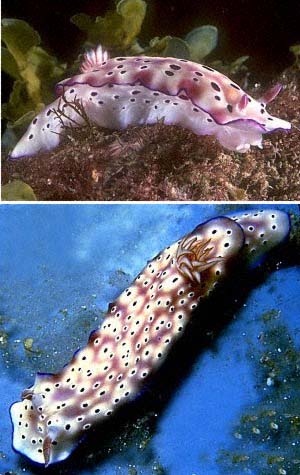
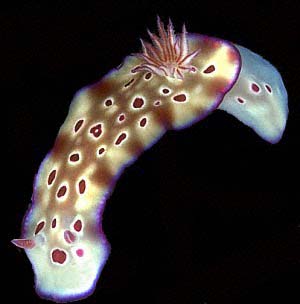
Risbecia tryoni
(Garrett, 1873)
Order: NUDIBRANCHIA
Suborder: DORIDINA
Family: Chromodorididae
DISTRIBUTION
Tropical Western Pacific.
PHOTO
UPPER: Coffs Harbour region, northern New South Wales, Australia, December 1990. PHOTO: Bill Rudman.
MIDDLE: Gorgonia Hole, Heron Is., Qld. 15m, 20 Dec. 1980, 61mm long alive. PHOTO: G.Avern.
LOWER: juvenile, Solitary Is., northern New South Wales, October 1990. PHOTO: Bill Rudman.
This is one of a group of similarly coloured species which I have called the "Risbecia tryoni colour group". Other species include Chromodoris geminus, Chromodoris kuniei and Chromodoris leopardus. They all have large purple or purple-brown spots or marks, usually ringed with white, an often reticulate brownish background, and a purple border. Chromodoris geminus differs in having four colour bands around the mantle edge, an outermost white, then translucent greyish purple, then white, then yellow. The other three have a distinct purple line at the border, narrow in C. leopardus and R. tryoni, but broad in C. kuniei. The shape of the body of R. tryoni, high with a reduced mantle overlap, is typical of the genus Risbecia. The three species of Chromodoris have a wide mantle overlap. Of the three with the purple mantle edge, C. leopardus and C. kuniei can be distinguished from R. tryoni by the broad purple border, consisting of three slightly different coloured bands in C. kuniei, and by the leopard-like multiple spots, or marks, forming a hollow square, found in C. leopardus.
References:
• Rudman, W.B. (1984) The Chromodorididae (Opisthobranchia: Mollusca) of the Indo-West Pacific: a review of the genera. Zoological Journal of the Linnean Society 81: 115-273.
• Rudman, W.B. (1987) The Chromodorididae (Opisthobranchia: Mollusca) of the Indo-West Pacific: Chromodoris epicuria, C. aureopurpurea, C. annulata, C. coi and Risbecia tryoni colour groups. Zoological Journal of the Linnean Society 90: 305-407.
Rudman, W.B., 1999 (January 22) Risbecia tryoni (Garrett, 1873). [In] Sea Slug Forum. Australian Museum, Sydney. Available from http://www.seaslugforum.net/find/risbtryo
Related messages
Risbecia tryoni from Indonesia
December 10, 2009
From: Mónica Alonso
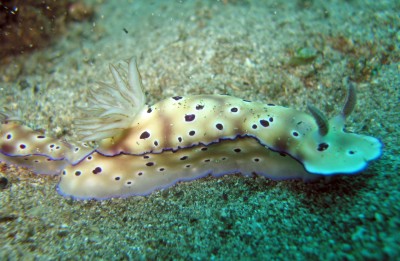
Hello Bill:
Here you are a sea slug found in Bunaken National Park in Sulawesi, Indonesia.
We don´t know which of this species is:
Risbecia tryoni
Chromodoris kuniei
Chromodoris geminus
Chromodoris leopardus
Locality: Manado, Bunaken National Park, Sulawesi, 10-12 m, Indonesia, Indo Pacific, 6 April 2007, Muddy. Length: 20-25 mm. Photographer: Mónica Alonso & Luis Abad.
Thank you in advance.
Mónica Alonso
monicaalonso091170@hotmail.com
Mónica Alonso, 2009 (Dec 10) Risbecia tryoni from Indonesia. [Message in] Sea Slug Forum. Australian Museum, Sydney. Available from http://www.seaslugforum.net/find/22952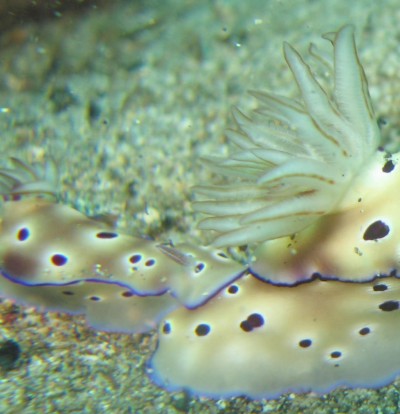
Dear Mónica,
This is R. tryoni. I discuss the differences between these species on the Fact Sheet. In your photo, the best clue is the front end of a second animal at the back of the first one. This behaviour of two or three animals following each other in a line - often touching head and 'tail' - is characteristic of species of Risbecia. Have a look at the Trailing Fact Sheet.
Best wishes,
Bill Rudman
Feeding Risbecia tryoni from Vanuatu
October 29, 2009
From: Leanne and David Atkinson
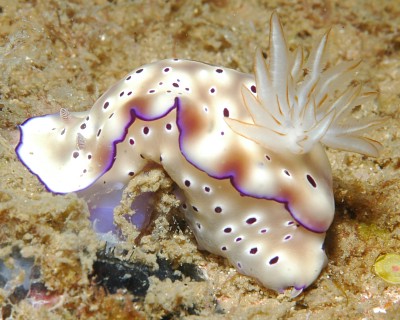
Concerning message #19916:
Dear Bill,
Following on from the discussion of Risbecia tryoni and food here are some photos from Mele Reef in Vanuatu of one with its head buried in an overgrown sponge. We've taken it from different angles to help identify the sponge and whether it was feeding.
Locality: Aloara Wreck, Mele Reef, Hideaway Island, 20 metres, Efate Island, Vanuatu, Pacific Ocean, 14 April 2008, Coral Reef. Length: approximately 100 mm. Photographer: Leanne and David Atkinson.
Regards,
Leanne & David Atkinson
atk@hunterlink.net.au
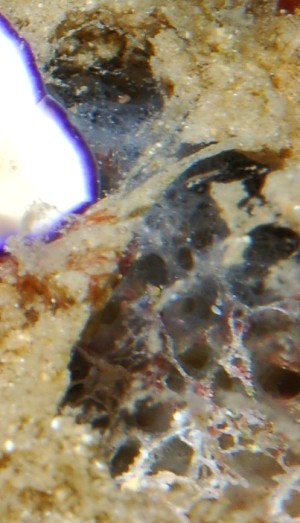
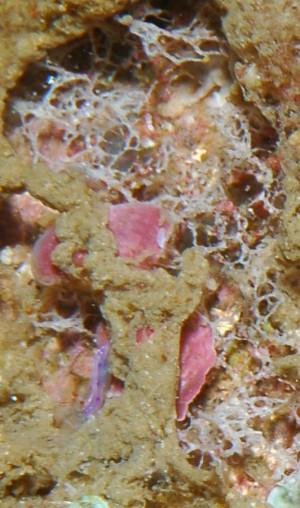
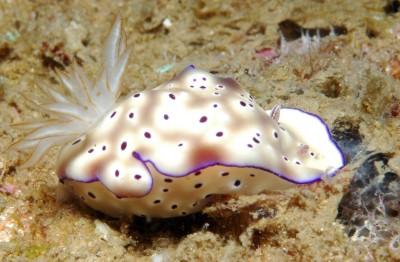
Dear Leanne and David,
Your photos well illustrate just how hidden the sponge colonies these chromodorids eat can be. Who would have thought that under the brownish dead-looking layer there could be living colonies. Your upper photo shows the purplish oral tube fully everted so the mouth - and teeth - can be extended down to the living sponge layer. I have included a couple of close-ups showing the sponge. In one of these all you can see is the net-like framework of spongin fibres which once formed the sponge's skeleton. I am sure this is the grey-blue species of dysideid we have found quite a few species of chromodorid feeding on [see Richard Swann's earlier message #19916]
Best wishes,
Bill Rudman
Re: Juvenile Risbecia tryoni from Vanuatu
February 25, 2009
From: Leanne and David Atkinson
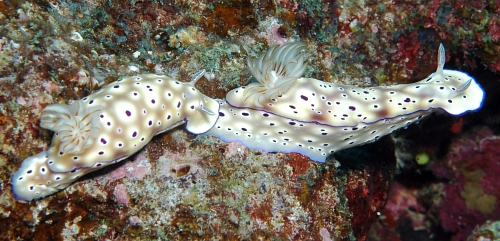
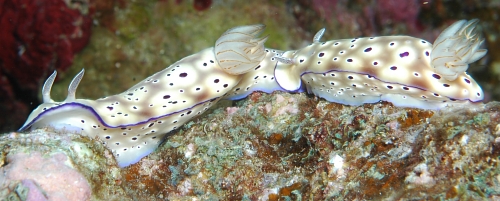
Concerning message #9191:
Hi Bill,
With the recent discussion of Risbecia tryoni we noticed there was only the juvenile in message #9191 from Vanuatu. During our trip last year to Hideaway Island, Vanuatu we found what we think are adult Risbecia tryoni trailing and then separating. You have lots of trailing shots already so we didn't send it in initially but since there aren't any adults on the forum from Vanuatu we thought these might be of interest. Thanks as always for your work on the forum we learn a lot from your work.
Locality: Kathleen Reef, Mele Reef, Hideaway Island, 20 metres, Vanuatu, Pacific Ocean, 18 April 2008, Coral Reef. Length: approximately 100mm. Photographer: Leanne and David Atkinson.
Regards,
Leanne & David Atkinson
atk@hunterlink.net.au
Atkinson, L. & D., 2009 (Feb 25) Re: Juvenile Risbecia tryoni from Vanuatu. [Message in] Sea Slug Forum. Australian Museum, Sydney. Available from http://www.seaslugforum.net/find/22285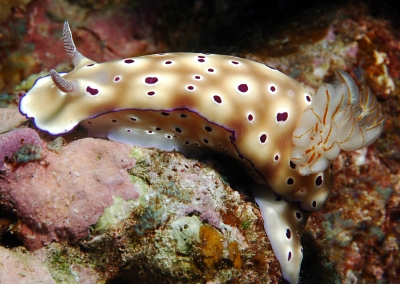
Dear Leanne and David,
Thanks for this record. Within certain limits, Risbecia tryoni is quite variable in color ranging from the relatively pale form in your photos with many small brown-purple spots to darker forms with larger less numerous spots. And we can't ignore the odd red spotted animal as illusrated by Julie Marshall [#16537] and Bruce Wilkie [#16573].
Best wishes,
Bill Rudman
Re: Risbecia pulchella at rest
February 18, 2009
From: Gary Cobb
Concerning message #22261:
Hi Bill and everyone!
I find it hard to believe this could be Risbecia pulchella. It looks more like Risbecia tryoni. The fact sheet photos look like Risbecia godeffroyana, both of which are found here in sthn Queensland. Risbecia pulchella dosen't have black spots with lighter areas around them like Risbecia tryoni.
Hummmm
Cheers,
Gary
gary@nudibranch.com.au
Cobb, G.C., 2009 (Feb 18) Re: Risbecia pulchella at rest. [Message in] Sea Slug Forum. Australian Museum, Sydney. Available from http://www.seaslugforum.net/find/22262Dear Gary,
I'm glad someone has their wits about them! While Marcel's message [#22261] was referring to Valda Fraser's message [#22255], which was of R. pulchella, the animal in Marcel's was indeed the purple-spotted R. tryoni rather than the yellow-spotted R. pulchella. My brain must have been in sleep mode when I answered that message. Interestingly Marcel's message suggests that the 'cuddling' behaviour may, like trailing, be a generic characteristic - and perhaps an attraction to that type of sponge is as well?
Best wishes,
Bill Rudman
Re: Risbecia pulchella at rest
February 17, 2009
From: Marcel Tanke
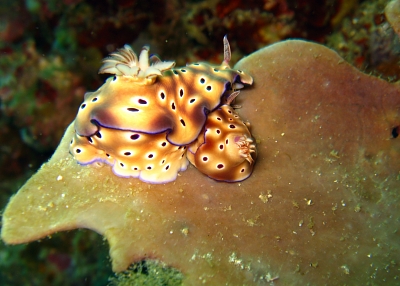
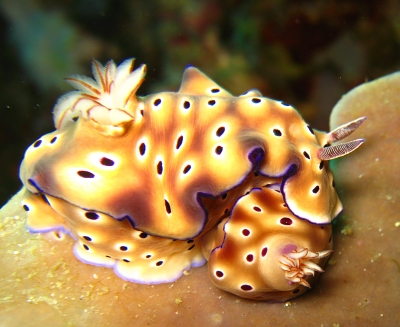
Note added 18 Feb 2009: The species in this message is Risbecia tryoni not R. pulchella. [See message #22262].
Concerning message #22255:
Hi Bill,
Maybe the "cuddling" is, like trailing, typical behaviour for Risbecia pulchella? The two in the pictures attached were moving, stopped and started "cuddling". I watched them a couple of minutes, they definitively were not mating during that time. But they continued moving over each other.
The pictures were taken at a 50 seconds interval.
Locality: Anilao, 10-15 m, Philippines, 13 July 2008. Length: max 4 cm. Photographer: Marcel Tanke.
Best regards,
Marcel
marceltanke@cs.com
Tanke, M.A., 2009 (Feb 17) Re: Risbecia pulchella at rest. [Message in] Sea Slug Forum. Australian Museum, Sydney. Available from http://www.seaslugforum.net/find/22261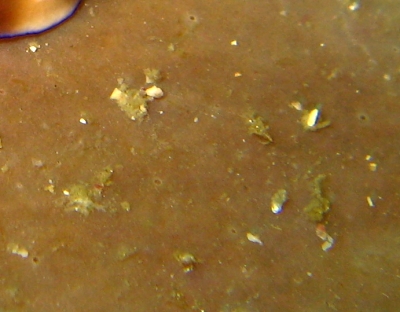
Dear Marcel,
Thanks for this quick response. Perhaps its some form of 'foreplay' preceding mating or a way to check if the partner is mature, or maybe they are just an affectionate species. It would be good to get some more observations.
In Valda Fraser's message, which you refer to, I made mention of the sponge her animals were on. Amazingly, I think your animals are on the same or a related species, which sometimes forms flat layers and other times a cup-shaped colony. As I mentioned in her message, it is not the type of sponge I would expect this species to eat, but finding R. pulchella associated with it in two oceans is quite interesting. The sponge looks to me like a Phyllospongia [Fam. Thorectidae], but I will need to get that checked by an expert. We only have records of Risbecia feeding on dysideid sponges, such as Euryspongia [see message #17602], but as we only have a few records at present, their food choice may be a little more complicated than we thought. It goes without saying that more records of 'cuddling' and association with this sort of sponge are very welcome
Best wishes,
Bill Rudman
Risbecia tryoni from the Philippines
June 30, 2008
From: Carrie Lo
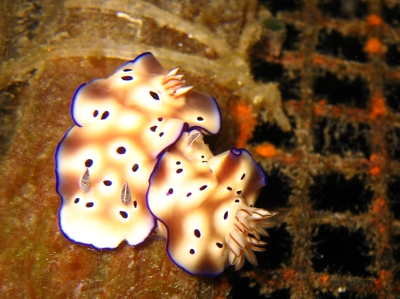
Dear Bill,
I found this pair of Nudis mating on a wooden fence during a night dive. Not sure if they are Risbecia tryoni.
Locality: Medicare South, Southern Leyte, 8m, Philippines, 22 Dec 2007. Length: 2cm. Photographer: Carrie Lo.
Cheers,
Carrie
carrielohc@yahoo.com.hk
Lo, C., 2008 (Jun 30) Risbecia tryoni from the Philippines. [Message in] Sea Slug Forum. Australian Museum, Sydney. Available from http://www.seaslugforum.net/find/21584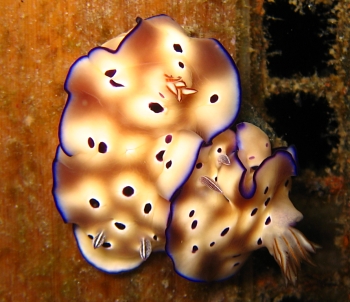
Dear Carrie,
Yes these are Risbecia tryoni but although they are nestled together, they need to have their right sides together - where their mating organs are located - before they can mate.
Best wishes,
Bill Rudman
Risbecia tryoni trailing
December 11, 2007
From: Mirjam Broos
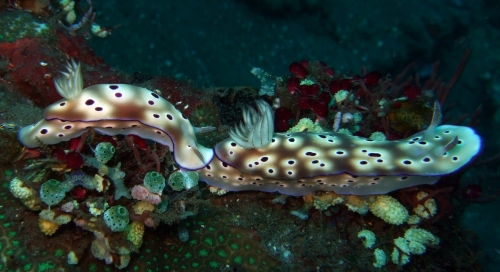
Hi Bill,
No questions in this message for a change. I just thought these are some nice pictures of Risbecia tryoni tailing.
Locality: Tulemben wreck, Bali, Indonesia, Indian ocean, 02 april 2007. Photographer: Geert Prast.
Mirjam
mirjam.broos@planet.nl
Broos, M., 2007 (Dec 11) Risbecia tryoni trailing. [Message in] Sea Slug Forum. Australian Museum, Sydney. Available from http://www.seaslugforum.net/find/21281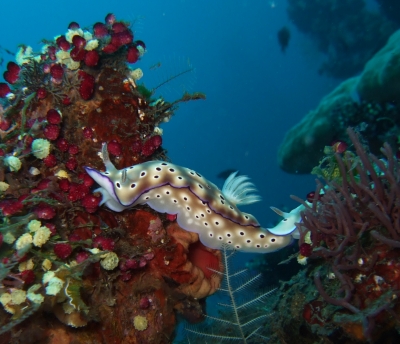
Thanks Mirjam,
Trailing is an interesting behaviour. Although there are many 'sensible' theories on why it occurs, we really have know idea of its function.
Best wishes,
Bill Rudman
Risbecia tryoni - what's in its mouth?
August 18, 2007
From: Elien Nijland
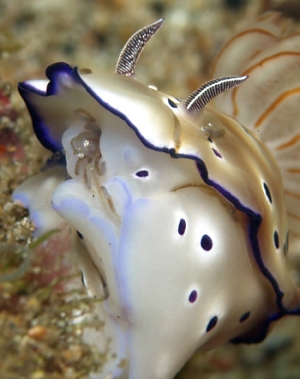
We took this picture at Raja Ampat and would like to know what is sticking out of its mouth
Locality: Island, 6 metres, Raja Ampat, Indonesia, South Pacific, 20 June 2007, sandy rock. Length: 40 mm. Photographer: Elien Nijland.
Elien Nijland
elien_nijland@planet.nl
Nijland, A.L., 2007 (Aug 18) Risbecia tryoni - what's in its mouth?. [Message in] Sea Slug Forum. Australian Museum, Sydney. Available from http://www.seaslugforum.net/find/20470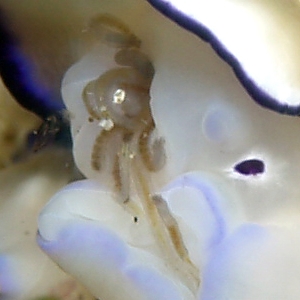
Dear Elien,
It looks like a crab. I am not an expert on crabs but it reminds me of a pinnotherid crab which are a group of commensals living in the mantle cavity of large bivalves and the tubes of other invertebrates. However, I don't know of one living in sponges, which are the food of Risbecia. Unless someone has a better idea I think how it got in the nudibranch's mouth will remain another of life's little mysteries
Best wishes,
Bill Rudman
Chromodoris leopardus - just a nice photo
August 17, 2007
From: Ken Tucker
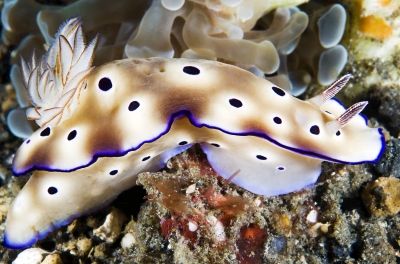
Here's a photo of Chromodoris leopardus - just because it looks so pretty...
Locality: North Sulawesi, Lembeh Strait, 15 metres, Indonesia, Celebes Sea, 4 Nov 2005. Length: 2 cm. Photographer: Ken Tucker.
Ken Tucker
ken@kilili.com
Tucker, K.C., 2007 (Aug 17) Chromodoris leopardus - just a nice photo. [Message in] Sea Slug Forum. Australian Museum, Sydney. Available from http://www.seaslugforum.net/find/20464Thanks Ken,
I think these animals are always out to trick us. This is Risbecia tryoni. As I discuss on the Fact Sheet for Chromodoris leopardus, there are a group of very similarly coloured species. I gave C. leopardus its name, because like the leopard, the spots are usually in groups of four.
Best wishes,
Bill Rudman
Risbecia tryoni - Trailing behaviour
July 26, 2007
From: Kerem Turker
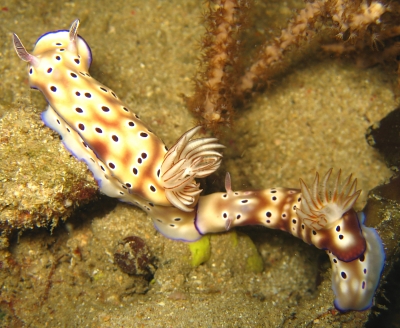
Hi Bill,
During a shallow dive along the Passage in Raja Ampat, there were numerous pairs of Risbecia tryoni trailing every couple of meters from each other. - "Nudies doing things".
Locality: The Passage - Raja Ampat, 8 meters, Indonesia, SW Pacific Ocean, 24 March 2007, Sandy bottom. Length: 30 mm to 60 mm in various lengths. Photographer: Kerem Turker.
Best Regards
Kerem
kerem.turker@pmintl.com
Tucker, K., 2007 (Jul 26) Risbecia tryoni - Trailing behaviour. [Message in] Sea Slug Forum. Australian Museum, Sydney. Available from http://www.seaslugforum.net/find/20193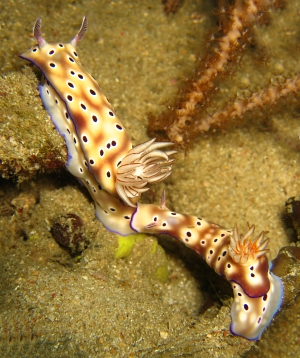
Thanks Kerem,
As you know I always welcome reports of "Nudies doing things". Trailing is a behaviour crying out for research. Why is it so pronounced in some genera and some species? And what is its value to them? Is it an efficient way of finding food perhaps, or a prelude to mating? Another of life's little mysteries.
Best wishes,
Bill Rudman
Injured Risbecia tryoni
July 23, 2007
From: Clinton Bauder
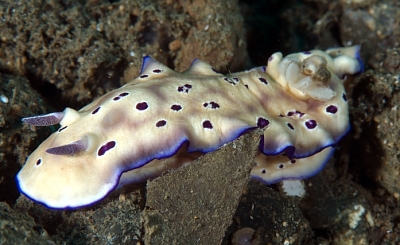
Hi Bill,
I found this rather sad Risbecia tryoni in Milne Bay which looks to have had its gills nibbled off by a predator. While not quite dead yet it certainly did not look to be thriving.
Locality: Michelle's Reef, 8 meters, Milne Bay, Papua New Guinea, Pacific, 1 April 2007, Sandy bottom. Length: 50 mm. Photographer: Clinton Bauder.
Clinton
gecko1@apple.com
Bauder, C., 2007 (Jul 23) Injured Risbecia tryoni. [Message in] Sea Slug Forum. Australian Museum, Sydney. Available from http://www.seaslugforum.net/find/20116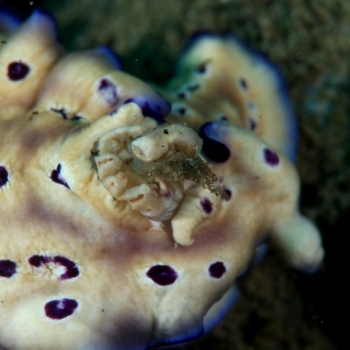
Dear Clinton,
The drooping rhinophores certainly give it an air of defeat - I agree it doesn't look long for this world
Best wishes,
Bill Rudman
Feeding Risbecia tryoni from Borneo
May 16, 2007
From: Richard Swann
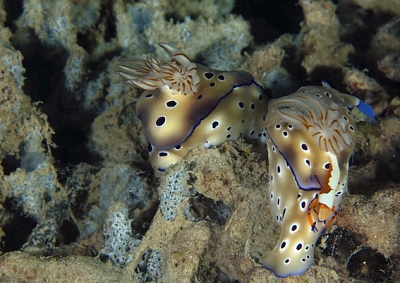
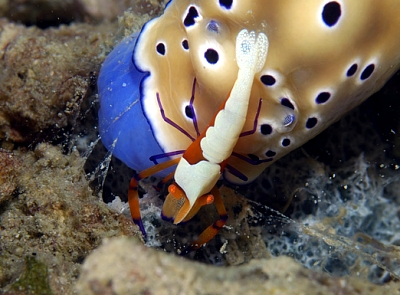
Hello Bill
I couldn't help but post this feeding record of Risbecia tryoni. It was taken on the same sponge colony as the Hypselodoris kanga I recently posted [message #19897] (still there feeding by the way) in fact within a couple of square feet we have Mexichromis multituberculata, H. kanga and R. tryoni all feeding on the same sponge.
Locality: Mamutik island,Kota Kinabalu, 11meters, Sabah, Borneo, South China Sea, 15 May 2007, sheltered reef. Length: Approx 40mm. Photographer: Richard Swann.
The partner shrimp just adds to this wonderful banquet it rather reminds me of a cat sitting on your head eating from your dinner plate. The first photo shows some of the colony in the background.
I have only ever seen one partner shrimp on a Nudi before is this very rare ?
Best regards
Richard
www.downbelow.co.uk
richard@downbelow.co.uk
Swann, R., 2007 (May 16) Feeding Risbecia tryoni from Borneo. [Message in] Sea Slug Forum. Australian Museum, Sydney. Available from http://www.seaslugforum.net/find/19916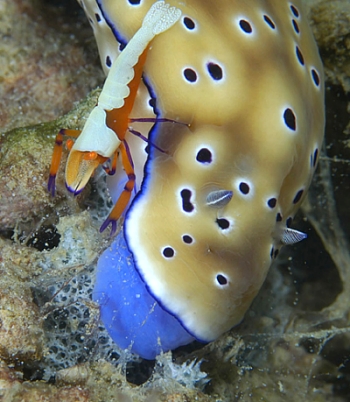
Dear Richard,
As I am sure you realise, I can't get enough of the these feeding records. These photos illustrate another point I have made regularly about the problems in catching these animals feeding whe often their sponge food is hidden under an overgrowing layer of either plant or animal - or in this case, a temporary layer of sediment which is entangled in a mucous sheet produced by the sponge. If it weren't for the 'feeding scars' where they have bitten through the sediment layer, we would have no idea that a large sponge colony lay beneath. This sponge, a species of Dysidea, is the only sponge we have found this species eating.
It is fascinating to see the 'partner shrimp' Periclimenes imperator ' apparently benefitting from its partnership. It is quite common on many large sea slugs. If you do a search on the Forum for Periclimenes you will get a long list of records of it on various species.
Best wishes,
Bill Rudman
Risbecia tryoni from the Philippines
April 3, 2007
From: Dr. Christine Meier
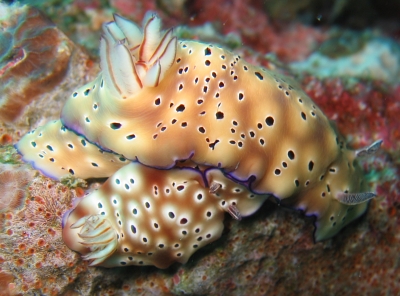
Dear Bill,
We found this pair of nudibranchs during a wall dive at Cebu, Philippines, on a clam. Can you confirm that the belong to Risbecia tryoni?
Locality: Dive site: Whitehouse Point, about 15 m, Cebu, Phillipines, Pacific, 04 March 2007, carol reef, wall. Photographer: Tine Meier.
Thanks + best regards,
Tine and Schade
tinemeier@web.de
Meier, T.S., 2007 (Apr 3) Risbecia tryoni from the Philippines. [Message in] Sea Slug Forum. Australian Museum, Sydney. Available from http://www.seaslugforum.net/find/19782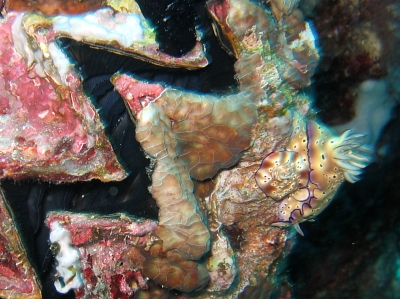
Dear Tine,
Nice find. They are Risbecia tryoni. Although I shouldn't be veering away from sea slugs, the 'clam' they are on is more correctly an oyster of the subfamily Lophininae. Although Americans tend to use the common name 'clam' for all bivalves, the rest of the world tends to use 'clam' as a common name only for the species of the family Tridacnidae. This solves the problem I noticed in a book recently, where the common name of Tridacna maxima is Large Giant Clam and for Tridacna gigas it is Giant Giant Clam.
Best wishes,
Bill Rudman
Strange Risbecia tryoni from Indonesia
March 8, 2007
From: Fred Vogt

Dear Bill,
Enclosed I send you a photo of Risbecia tryoni.
Locality: Tanjung Kubur; Lembeh Strait; Kungkungan Bay Resort; , 12 metres, Indonesia; North Sulawesi, Western Pacific, 29. October 2006, lava sand. Length: 40 mm. Photographer: Fred Vogt.
On the photo you see some details, I cannot interpret:
The funnel between the rhinophores. What is that? What is it for?
The violet "things" beside the gills. Are that eggs? Is that excretion?
Would be nice to hear from you.
Regards from Hamburg.
Fred Vogt
Reticulata@gmx.net
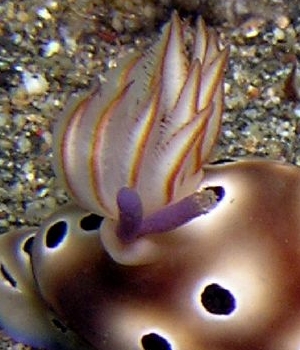
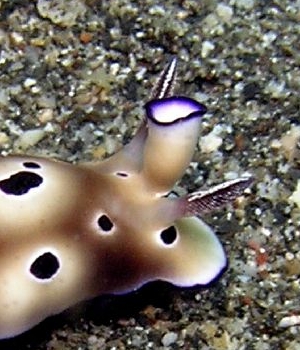
Dear Fred,
This is another one for the abnormalities Fact Sheet. Surprisingly, this is the third species of chromodorid with a cone-shaped growth between the rhinophores [see C. magnifica - #10212; C. kuniei - #9918 ]. This structure is a developmental abnormality with no function.
Concerning the two sausage-shaped purple structures by the gills, they are indeed egg sacs, but not of the Risbecia. They are the eggs of a parasitic copepod living inside the slug. For those of you unfamiliar with copepods, they are a group of usually small crustacea in which the females carry a pair of sausage-shaped egg sacs on their tail.
Best wishes,
Bill Rudman
Re: Risbecia tryoni - trailing observations:
August 29, 2006
From: Jack Connick
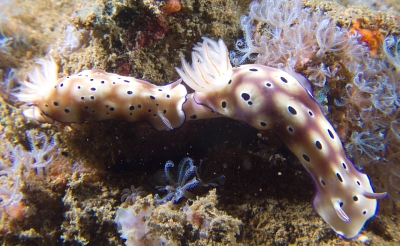
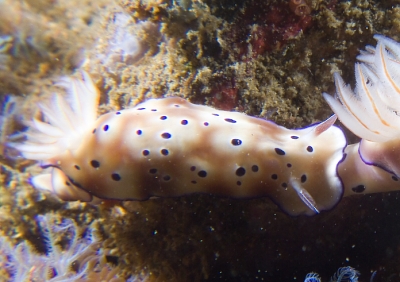
Concerning message #17506:
Hi Bill;
Here's a pair of Risbecia tryoni I shot in N. Sulawesi that seems to show the opposite also, ie one with smaller spots trailing one with larger ones.
Locality: Malawi Wreck, 60', North Sulawesi, Indonesia, Lemba Straits, North Pacific, 2 May 2006, Top of wreck. Length: 6". Photographer: Jack Connick.
Jack Connick.
JackConnick@Yahoo.com
Connick, J., 2006 (Aug 29) Re: Risbecia tryoni - trailing observations:. [Message in] Sea Slug Forum. Australian Museum, Sydney. Available from http://www.seaslugforum.net/find/17601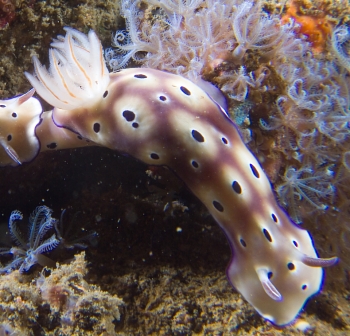
Thanks Jack,
The spot theory seemed perfectly reasonable until we got some facts! What is interesting is how this focussing on the spots has shown us just how variable Risbecia tryoni is in the number and size of spots, and the nature of the darker background reticulation on the mantle.
Best wishes,
Bill Rudman
Trailing Risbecia tryoni from Malaysia
August 26, 2006
From: Sven-Urban Fjellner
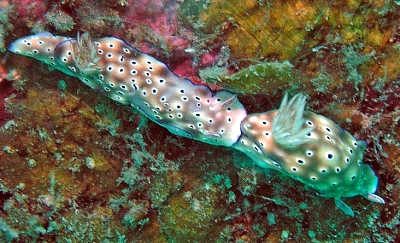
Dear Bill,
This is a recent photo of the trailing behaviour in nudibranchs. As can be seen the smaller one is apparently leading. To me these look like Risbecia tryoni, but inexperienced as I am I wouldn't bet my life on it...
(I have to apologise for the mediocre picture quality, but I tried to best the camera in knowing better what settings to use - guess what, the camera IS better...)
Locality: Pulau Redang, 10 - 18m, Malaysia, South China Sea, 24 July 2006, Reef. Photographer: Sven-Urban Fjellner.
Sven-Urban Fjellner
diver@kanakoto.net
Fjellner, S-U, 2006 (Aug 26) Trailing Risbecia tryoni from Malaysia. [Message in] Sea Slug Forum. Australian Museum, Sydney. Available from http://www.seaslugforum.net/find/17564Dear Sven-Urban,
Yes this is a pair of Risbecia tryoni trailing. In this case the two animals seem to be about the same size - the front one is a bit contracted - and the spots in each seem to be of similar size and number.
Best wishes,
Bill Rudman
Re: Risbecia tryoni - trailing observations:
August 26, 2006
From: Roberto Sozzani
Concerning message #17506:
Dear Bill,
What I've noticed about Risbecia tryoni is that they are very often in couples, resting side by side, touching each other, but not mating. It seems they like a physical contact. I've several photos showing this behaviour, I only need to find them. With other species, on the contrary, a couple side by side is almost everytime mating.
Maybe is not a "bright idea", but what if the trailing behaviour is just a way to keep this physical contact also when they are crawling around? If this is true, trailing behaviour is only one aspect of a wider general need (or pleasure?) to always keep reciprocal contact.
Best wishes
Roberto Sozzani
www.robertosozzani.it
roberto.sozzani@fastwebnet.it
Sozzani, R., 2006 (Aug 26) Re: Risbecia tryoni - trailing observations:. [Message in] Sea Slug Forum. Australian Museum, Sydney. Available from http://www.seaslugforum.net/find/17592Dear Roberto,
I'm not sure how far we can go with sea-slug emotions. Trailing behaviour is a fascinating phenomenon which we still know little about. Quite a few species follow the mucus trails of others of their own species apparently to meet, mate and perhaps find food, and there are others which are predators, which follow the mucus trails of potential prey. However there also seem to be this third group which compulsively 'trail' others of the same species, and don't have an 'off' switch.
Best wishes,
Bill Rudman
Risbecia tryoni - trailing observations:
August 24, 2006
From: Hugues Flodrops
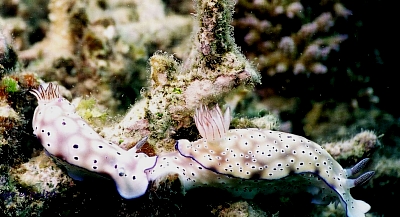
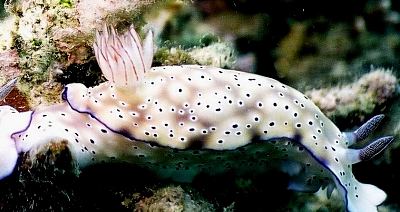
Dear Bill,
Another pair of Risbecia tryoni from New Caledonia don't confirm Asther M.Lau's suggestion [message #10918] that in trailing pairs ones with a few larger spots follow one with more small spots. Perhaps it is a coincidence, but it's seems there must be aother explanation.
Locality: Island " Ilot Canards", 2 metres, Noumea, New Caledonia, Pacific Ocean, 10 November 2004, apnea. Length: 50 mm. Photographer: Hugues Flodrops.
Bests Regards.
Hugues
hugues.flodrops@wanadoo.fr
Flodrops, H., 2006 (Aug 24) Risbecia tryoni - trailing observations: . [Message in] Sea Slug Forum. Australian Museum, Sydney. Available from http://www.seaslugforum.net/find/17506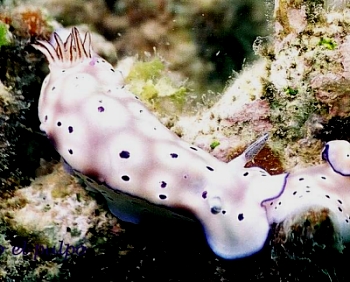
Dear Hugues,
As I said in reply to Asther's message, we have too little information to know whether her observation means anything. Certainly your animals show the opposite. Checking out suggestions like this is how we advance our knowledge so I always encourage 'bright ideas'. What we are basically looking for are patterns of behaviour which occur over and over again. At present there doesn't seem to be a pattern here. The major question still exists of course, and that is what is the reason for the trailing behaviour?
Best wishes,
Bill Rudman
Risbecia tryoni from Cook Island, Tweed Heads, NSW
June 12, 2006
From: Ian Banks
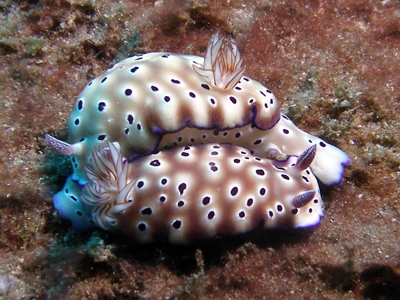
Bill,
These 2 Risbecia tryoni were observed on the North Side of Cook Island, Tweed Heads, NSW.
Locality: Cook Island, Tweed Heads , 12 metres, New South Wales, Australia, Pacific Ocean, 26 May 2006, Rocky Reef. Length: 4 cm. Photographer: Ian Banks.
Regards Ian
ianbanks@bigpond.com
Banks, I.W., 2006 (Jun 12) Risbecia tryoni from Cook Island, Tweed Heads, NSW. [Message in] Sea Slug Forum. Australian Museum, Sydney. Available from http://www.seaslugforum.net/find/16831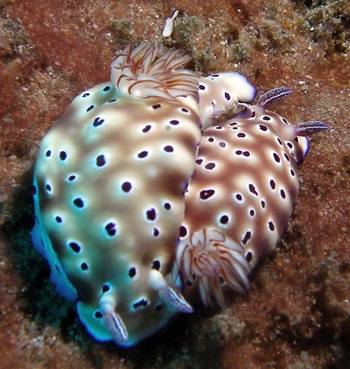
Dear Ian,
When I first saw your photos I thought the two animals were mating, but then I noticed that the two were left side to left side, rather than right side to right side. Nudibranchs have their genital openings on the right side, in the anterior quarter of the body, so for two animals to mate they need their right sides together, and their heads to be much closer to each other than in these photos.
On reflection, I think this is an example of two animals 'trailing' - that strange phenomenon where one animal follows another often with the 'follower' usually having its head on the posterior end of the foot of the 'leader'. Perhaps trailing is a prelude to mating, but if so the animals need to reorient themselves.
Best wishes,
Bill Rudman
Re: More on spots in Risbecia tryoni
May 11, 2006
From: Bruce Wilkie
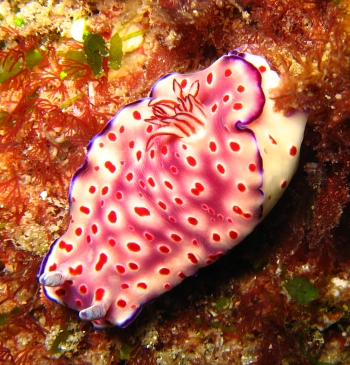
Concerning message #16537:
Hi Bill,
I have been reading Julie`s message #16537, Wayne`s message #16500 and Asther`s message #10918 about colour variation of spots on Risbecia tryoni. It reminded me of this animal which I have on file. I am reasonably sure it is R. tryoni. Its colour is quite different from other animals from this area. Thought you might like it for your records.
Locality: Manta Bommie Point Lookout North Stradbroke Island, 10 metres, Queensland Australia, Pacific ocean, 17 December 2005, rocky reef with sponges, hard & soft corals . Length: 80mm. Photographer: Bruce Wilkie.
Many Thanks,
Bruce Wilkie.
brucedwilkie@yahoo.com.au
Wilkie, B., 2006 (May 11) Re: More on spots in Risbecia tryoni. [Message in] Sea Slug Forum. Australian Museum, Sydney. Available from http://www.seaslugforum.net/find/16573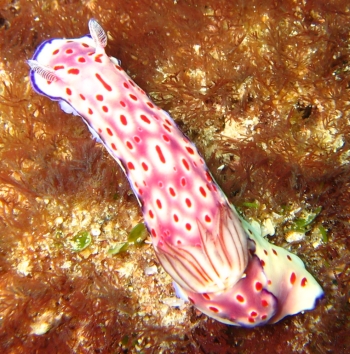
Dear Bruce,
Thanks for this example. Yes I am sure this is also one of this colour mistakes. I don't think we can call it a colour variant or part of the species colour range. I think it is an animal which is trying to produce dark purplish spots and background pattern but for some physiological reason has been unable to do so.
If I am right, I guess these animals should be considered developmental abnormalities on par with the morphological peculiarities listed on the abnormalities Fact Sheet
Best wishes,
Bill Rudman
Re: More on spots in Risbecia tryoni
May 8, 2006
From: Julie Marshall
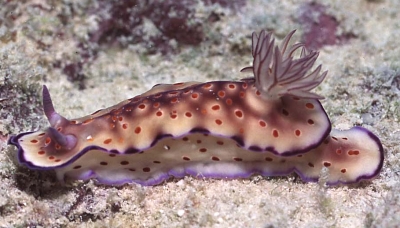
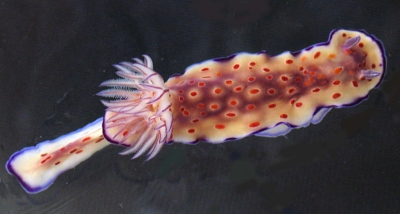
Concerning message #16500:
Dear Bill,
Attached are some photos of what seems to be Risbecia tryoni but which has red spots (and orange behind the rhinophores) rather than dark violet spots on the mantle. It was found wedged between coral in a deep coral pool behind the reef crest during a high low tide at Heron Island [Great Barrier Reef] and was 65 mm in size.
Locality: Heron Island, Great Barrier Reef, 2 m., Queensland, Australia, Pacific Ocean, 16 March 2005, Intertidal. Length: 65 mm. Photographer: Julie Marshall.
Best wishes,
Julie Marshall
juliemarshall@netspace.net.au
Marshall, J.G., 2006 (May 8) Re: More on spots in Risbecia tryoni. [Message in] Sea Slug Forum. Australian Museum, Sydney. Available from http://www.seaslugforum.net/find/16537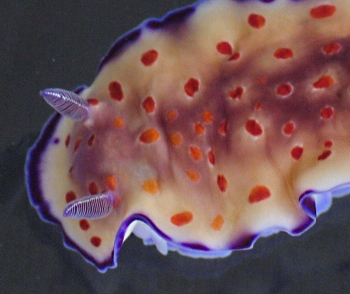
Dear Julie,
I agree with your identification. I think its important to see the whole colour pattern when identifying a species. Sometimes if we get stuck on the exact colour of some spots or lines we may miss what really distinguishes a species and that is its total colour pattern. For example, quite a few of the black-lined chromodorids at times have parts of their lines coloured orange brown.
Another possible example is Chromodoris buchananae, which is known from a single specimen from nthn New South Wales in eastern Australia. I wouldn't be at all surprised if it is an 'albino' form of C. kuiteri in which the areas which normally have black pigmentation could only make an orange colour. As far as I know, no other specimens with this colour form of been found before or since.
I suspect there is something peculiar happening in the colour making physiology of the cells involved - either a gene disorder or perhaps the absence of a vital precursor or pigment. It's the sort of thing I would love to interest a biochemist in but it is hard to guarantee that 'normal' and 'aberrant' specimens would be available when needed for study.
Best wishes,
Bill Rudman
Re: More on spots in Risbecia tryoni
May 5, 2006
From: Wayne Atkinson
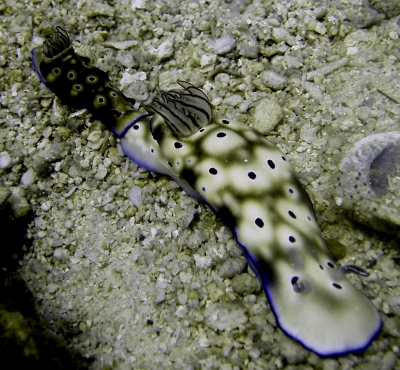
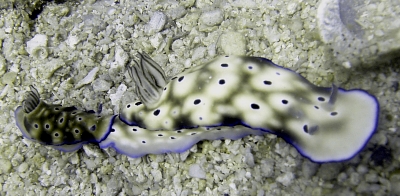
Concerning message #10918:
Hi Bill
Following on from the post on Risbecia trailing and the patterns of leader and follower I thought you might be interested in these photos showing a light form being followed by a quite different smaller darker form with a rosette-like patterning around the spots.
Locality: Dumaguete, , 10m, Philippines, Indo-pacific, September 2004, coral sand. Photographer: Wayne Atkinson.
Love the forum btw.
Wayne
wayne.atkinson@blueyonder.co.uk
Atkinson, W., 2006 (May 5) Re: More on spots in Risbecia tryoni. [Message in] Sea Slug Forum. Australian Museum, Sydney. Available from http://www.seaslugforum.net/find/16500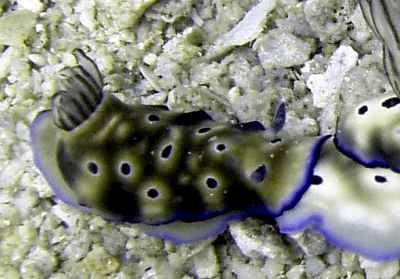
Dear Wayne,
Thanks for the photos. I doubt if it Nobel Prize sort of stuff but I would really like to know what the purpose of 'trailing' is. I know there are 'common sense' explanations like keeping together for mating or making it easier for the 'follower' to find food, but there are many species of chromodorids that don't trail, and they seem to survive quite successfully.
Concerning the colour of the small animal. I don't recall seeing one quite as dark as that. Perhaps it only makes back pigment as a juvenile and so becomes lighter as it grows. But then if you look at other messages on this species there are photos of juveniles which are much lighter in colour so I guess it is just a colour variant..
Best wishes,
Bill Rudman
Risbecia tryoni feeding
February 25, 2006
From: Bruce Wilkie
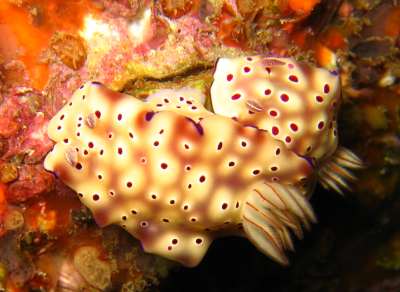
Hi Bill,
I could not find much on risbecia tryoni feeding so I have included three pairs feeding on what appears to be three different types of sponge.
Lower left: 19 February 2006, Flat Rock. 7 mtrs. Upper right: 14 January 2006, Flat rock (underside of an overhang) 14 mtrs 60 mm. Lower right: 15 January 2006. Manta Bommie 12 mtrs, 80 mm.
Locality: Flat Rock North Stradbroke Island, 7 metres, Queensland Australia, Pacific ocean, 19 February 2006, rocky reef with sponges, hard & soft corals . Length: 70 mm. Photographer: Bruce Wilkie.
Many Thanks
Bruce Wilkie.
brucedwilkie@yahoo.com.au
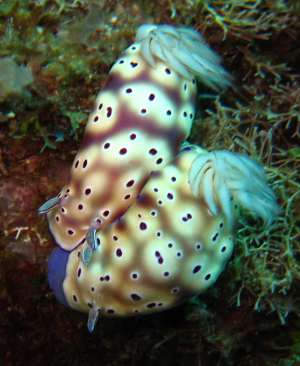
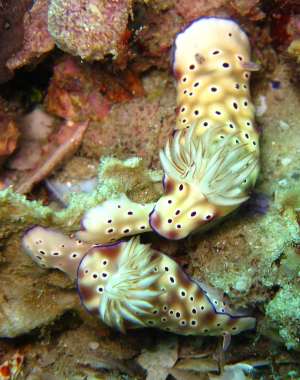
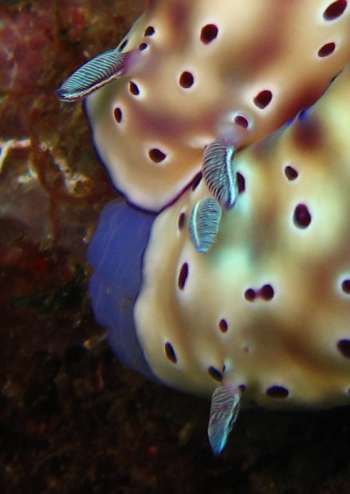
Dear Bruce,
I wouldn't be at all surprised if they are all feeding - and certainly the one alongside with its purple oral tube everted is definitely feeding. However, as luck would have it I cant see any identifiable sponge. This is often the case in the field. Not all sponges are clean and in huge colonies. Often they are overgrown with algae or other colonies and so a nudibranch may be feeding on a small morsel which we can't see beacuse it has its oral tube over the lot.
Any way thanks for trying. Perhaps we will have better luck next time.
Best wishes,
Bill Rudman
Re: Another pair of Risbecia tryoni?
February 8, 2006
From: Erwin Kodiat
Concerning message #10914:
Bill,
I wonder why Risbecia tryoni is often trailing in pair?
Thanks
ungu@terong.com
Kodiat, E., 2006 (Feb 8) Re: Another pair of Risbecia tryoni?. [Message in] Sea Slug Forum. Australian Museum, Sydney. Available from http://www.seaslugforum.net/find/15743Dear Erwin,
There is a lot of stuff on the Forum, either in previous messages or in Fact Sheets. It is always a good idea to do a couple of searches using the Forum search box on the top left of each page. In this case just type in trailing and you'll find a Fact Sheet on trailing and quite a lot of other examples. I'm afraid none of them actually answer your question as we don't really know why they trail each other.
Best wishes,
Bill Rudman
Risbecia tryoni found on Sunshine Coast
November 13, 2003
From: Gary Cobb
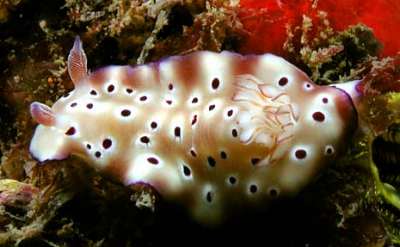
Hi Bill,
Please find attached a photo of Risbecia tryoni I found off Mooloolaba, SE Queensland, Australia at a site called Coles Hole, 20m depth, 40mm long, 20 degree water.
Cheers
Gary Cobb
gary@cobb.com.au
Cobb, G., 2003 (Nov 13) Risbecia tryoni found on Sunshine Coast. [Message in] Sea Slug Forum. Australian Museum, Sydney. Available from http://www.seaslugforum.net/find/11332Thanks Gary,
Bill Rudman
Another pair of Risbecia tryoni?
September 9, 2003
From: Asther M. Lau
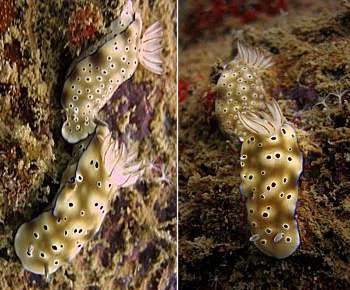
Hi!
Following my last message, I think this is another pair of Risbecia tryoni. They were crawling together along a small boulder downwards.
Funny thing is the one behind has smaller and more numerous spots.
Site: Sea Bell, Perhentian Is. Malaysia
Date: June 13th, 03
Depth: 15 meter
Water Temp: 26 degree celcius
Asther M. Lau
diveworldwide@yahoo.com
Lau, A.M., 2003 (Sep 9) Another pair of Risbecia tryoni?. [Message in] Sea Slug Forum. Australian Museum, Sydney. Available from http://www.seaslugforum.net/find/10914Thanks Asther,
As you'll see from the other photos on the Forum this species does show quite a lot of varaibility in size and number of spots
Best wishes
Bill Rudman
More on spots in Risbecia tryoni
September 9, 2003
From: Asther M. Lau
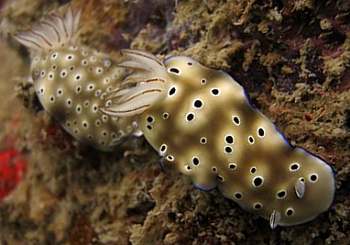
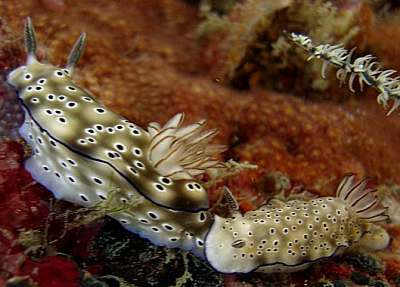
Hi Bill,
Following my message about spots in Risbecia tryoni - As I was going through my logbook and viewing the pics I've collected in it, I realised there were 2 similar pics at 2 different log pages.
As I checked the details, I realised these two pairs of Risbecia tryoni have the same characters:
• 1. Front one has bigger spots whilst the one behind has smaller & more spots
• 2. Both pairs travelled in a trailing style.
Upper Photo: Sea Bell, Perhentian Is. Malaysia
Depth: 12 meter
Date: June 13th 2003
Lower Photo: Terumbu Tiga, Perhentian Is. Malaysia
Depth: 16 meter
Date: July 11th, 2003
Asther M. Lau
diveworldwide@yahoo.com
Lau, A.M., 2003 (Sep 9) More on spots in Risbecia tryoni. [Message in] Sea Slug Forum. Australian Museum, Sydney. Available from http://www.seaslugforum.net/find/10918Dear Asther,
This is an interesting observation, but I am not sure if it just a coincidence or not. The other photos on the Forum don't show a similar pattern and a quick check through other photos I have don't show it either. It would certainly be worth looking out for pairs of Risbecia in the future to see how often many small spots follow a few larger spots.
Concerning the 'trailing' behaviour. There is a page on the Forum discussing 'trailing'. It is a common phenomenon amongst species of Risbecia
Best wishes
Bill Rudman
Risbecia tryoni from East Malaysia
September 6, 2003
From: Asther M. Lau
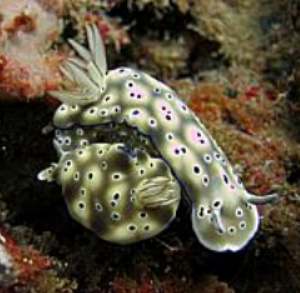
Dear Bill,
Found another pair of beauty here which I think is the species Risbecia pulchella. Can you please confirm this? Thanx!
Site: Soyak Wreck II, Tioman Is. Malaysia
Depth: 25 meter
Date: 9th August 2003
Asther M. Lau
diveworldwide@yahoo.com
Lau, A.M., 2003 (Sep 6) Risbecia tryoni from East Malaysia. [Message in] Sea Slug Forum. Australian Museum, Sydney. Available from http://www.seaslugforum.net/find/10873Dear Asther,
This is a species of Risbecia, but it is the purple-spotted Risbecia tryoni, not the yellow-spotted Risbecia pulchella.
Best wishes,
Bill Rudman
Risbecia tryoni trailing
July 7, 2003
From: Bruce Potter
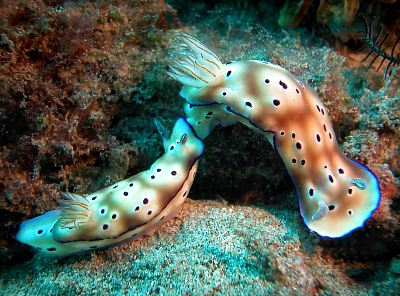
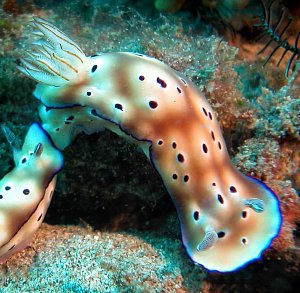
Dear Bill,
I dived my regular small boat wreck yesterday [25 June, 2003], just on the outskirts of Honiara, Solomon Islands.
Found these two Risbecia tryoni and thought they were worth sending in.
They were on rubble, at about 9 meters. The larger of the two was about 50mm long.
Regards
Bruce Potter
bpotter@Solomon.com.sb
Potter, B., 2003 (Jul 7) Risbecia tryoni trailing. [Message in] Sea Slug Forum. Australian Museum, Sydney. Available from http://www.seaslugforum.net/find/10297Thanks Bruce,
They are certainly showing their 'trailing' behaviour very well
Best wishes,
Bill Rudman
Juvenile Risbecia tryoni from Indonesia?
May 26, 2003
From: Roberto Sozzani
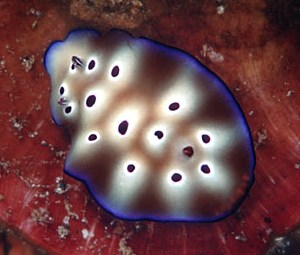
Dear Bill,
I'm back again with more questions...
I found this nudibranch in the island of Flores (Indonesia). Shape is like Chromodoris kuniei but mantle colors are those of Risbecia tryoni, so I think he can be a juvenile of the latter. Gills are not visible. Strange the brown dots near the mantle edge on the back.
Size: 15mm.
Depth: 12m.
What do you think?
Best regards
Roberto Sozzani
roberto.sozzani@fastwebnet.it
Sozzani, R., 2003 (May 26) Juvenile Risbecia tryoni from Indonesia?. [Message in] Sea Slug Forum. Australian Museum, Sydney. Available from http://www.seaslugforum.net/find/9921Dear Roberto,
Yes this is a juvenile R. tryoni. If you look at the other photos of this speies on the Forum you will see the brownish patches around the edge are usually present but they are proportionally much smaller in larger animals
Best wishes,
Bill Rudman
Juvenile Risbecia tryoni from Malaysia
May 9, 2003
From: Asther M. Lau
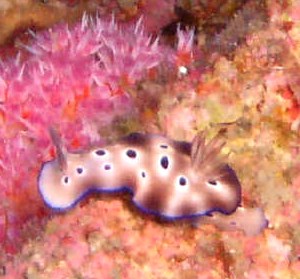
Please help confirm this species. Is it a Chromodoris geminus?
Date: 26th April 2003
Location: Tokong Burung, Tenggol Is. Malaysia
Size: 1.5cm long
Depth: 26m
Asther M. Lau
asther@scubadiveknit.com
Lau, A.M., 2003 (May 9) Juvenile Risbecia tryoni from Malaysia. [Message in] Sea Slug Forum. Australian Museum, Sydney. Available from http://www.seaslugforum.net/find/9819Dear Asther,
There are a number of purple spotted species which look quite similar externally. I discuss the differences between these species on the Chromodoris geminus Fact Sheet. I am pretty sure this is a juvenile Risbecia tryoni.
Best wishes,
Bill Rudman
Juvenile Risbecia tryoni from Vanuatu
February 22, 2003
From: Vinka Stenhouse
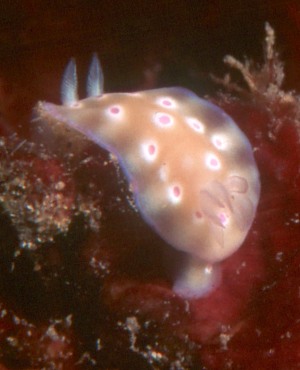
Hi Bill
This nudibranch was found at a depth of 9 metres at Santo, Vanuatu.
Is it a juvenille?
Regards,
Vinka
vinkas@oceanaphotography.com
Stenhouse, V., 2003 (Feb 22) Juvenile Risbecia tryoni from Vanuatu. [Message in] Sea Slug Forum. Australian Museum, Sydney. Available from http://www.seaslugforum.net/find/9191Dear Vinka,
from the background material it certainly looks quite small. Juveniles are sometimes difficult to be sure of but I am pretty sure this is a juvenile Risbecia tryoni.
best wishes,
Bill Rudman
Risbecia tryoni from Indonesia
February 12, 2003
From: Kelvin Tan
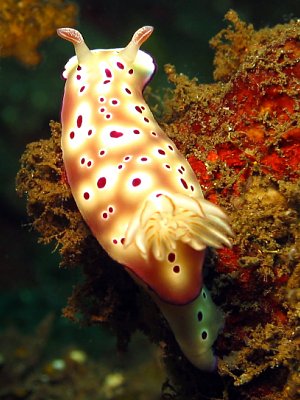
I could not find the scientific name for this sea slug and I would greatly appreciate your expertise in identifying them.
Image Data: found on 25th Jan 2003, Tulamben, Bali, Indonesia.
Greatly appreciated.
Kelvin Tan
lanxx@pacific.net.sg
Tan, K., 2003 (Feb 12) Risbecia tryoni from Indonesia. [Message in] Sea Slug Forum. Australian Museum, Sydney. Available from http://www.seaslugforum.net/find/9103Dear Kelvin,
This is Risbecia tryoni.
Best wishes,
Bill Rudman
Juvenile Risbecia tryoni from Lembeh Strait
December 14, 2002
From: Danny Van Belle
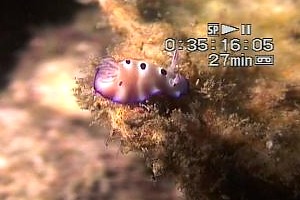
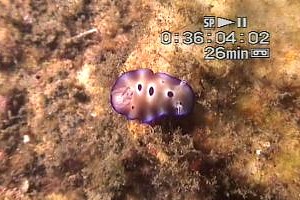
Hi again,
This Chromodoris I found in 5m depth at Lembeh Strait, Indonesia on 22/04/2002. Length 1.5cm. I can't find it back in my books.
Any idea?
Thanks,
Danny
dannyvb@hotmail.com
Van Belle, D., 2002 (Dec 14) Juvenile Risbecia tryoni from Lembeh Strait. [Message in] Sea Slug Forum. Australian Museum, Sydney. Available from http://www.seaslugforum.net/find/8573Dear Danny,
Juveniles are sometimes difficult to identify especially when they are one of a group of similarly coloured species. This is almost certainly a juvenile Risbecia tryoni. If you look at the bottom photo on the species page you will see an animal with an almost identical colour pattern [but with a lot fewer spots], and links to some similarly coloured species.
Best wishes,
Bill Rudman
Risbecia tryoni with copepod
October 4, 2002
From: Marli Wakeling
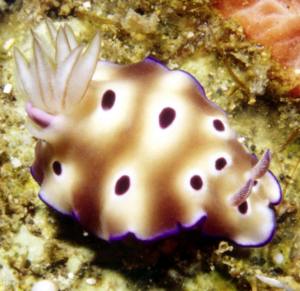
Hi Bill,
Another in the series from the same site, Nudi Falls. I thought that this was interesting because of the copepod in the critter's gills.
Location: Nudi Falls, Lembeh Straight, North Suluwesi, Indonesia.
Depth: 45 feet
Date: July 2002
Length: 2cm.
Photograph: Marli Wakeling
Marli
scubamarli@excite.com
Wakeling, M., 2002 (Oct 4) Risbecia tryoni with copepod. [Message in] Sea Slug Forum. Australian Museum, Sydney. Available from http://www.seaslugforum.net/find/8092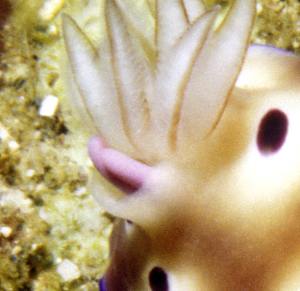
Thanks Marli,
It's nice to get records of these copepod parasites. For those of you unfamiliar with copepods, they are a group of usually small crustacea in which the females carry a pair of sausage-shaped egg sacs on their tail. In this photo the two purple 'sausages' extending out of the gill pocket are the egg sacs of a copepod parasitising this Risbecia.
Best wishes,
Bill Rudman
Risbecia tryoni from Sulawesi
July 12, 2002
From: Helmut Schirmböck
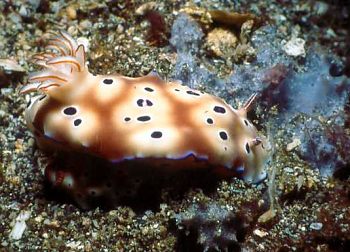
Hare is another photo from the Bunaken Is - Lembeh Strait region of Nth Sulawesi, Indonesia, [April-May, 2002].
Regards,
Helmut.
schirmis@aon.at
Schirmböck, H. , 2002 (Jul 12) Risbecia tryoni from Sulawesi. [Message in] Sea Slug Forum. Australian Museum, Sydney. Available from http://www.seaslugforum.net/find/7443Dear Helmut,
This is Risbecia tryoni.
Cheers,
Bill Rudman
Risbecia tryoni from Julian Rocks, nthn NSW
July 1, 2002
From: David Wachenfeld
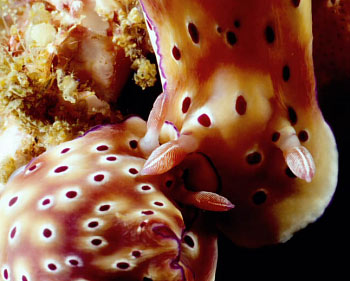
Hello Bill
I took the attached photograph at Julian Rocks, off Byron Bay in northern New South Wales, on the east coast of Australia in December 2001.
I'd be very grateful for any information you can give me on species id's and behaviour of what the nudi's are doing.
Regards,
David
triggerfish@bigpond.com
Wachenfeld. D., 2002 (Jul 1) Risbecia tryoni from Julian Rocks, nthn NSW. [Message in] Sea Slug Forum. Australian Museum, Sydney. Available from http://www.seaslugforum.net/find/6402Dear David,
This is a species of chromodorid called Risbecia tryoni. All I can say about what they are doing is what you can see - they are touching their 'heads' together. If you have a look at the other messages on the page you will see that this species, and other species of Risbecia have a behaviour we commonly call 'trailing' where one follows another animal very close behind - probably following its mucous trail. This may be a prelude to mating but it has not been studied in detail, although it has been observed often. It is possible your animals are 'getting to know each other' as a preliminary to mating but that is only a guess,
Best wishes,
Bill Rudman
Risbecia tryoni and food
June 10, 2002
From: Nishina Masayoshi
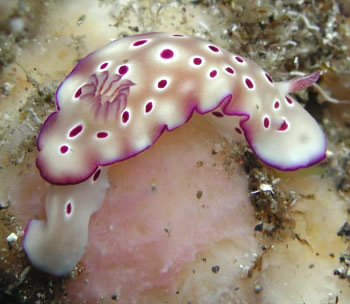
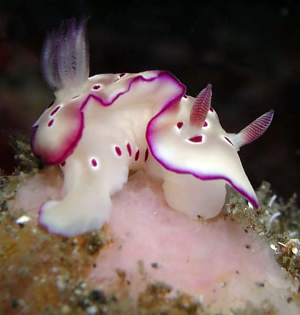
Dear Bill,
I attached photos of Risbecia tryoni. The owner of the diving operator Koutaro Tanaka tells me that the animal is there as long as the cream colored sponge is there.
Interestingly, the color of the sponge turned pinkish after R.ryoni has eaten eat the surface of the sponge.
Date: 20 April, 2002
Location: Hachijo Island Japan
Depth:13m
Length: 25mm
Photo by N.Chikako
Best Regards,
Nishina Masayoshi
nishina@wips.co.jp
Masayoshi, N., 2002 (Jun 10) Risbecia tryoni and food. [Message in] Sea Slug Forum. Australian Museum, Sydney. Available from http://www.seaslugforum.net/find/6874Dear Nishina,
Thanks to you and Koutaro Tanaka for this interesting information and to Chikako for the nice photos. Sometimes digestive enzymes can cause tissue to chnage colour like this and sometimes just physical damage can cause sponges to change colour - a bit like fruit going brown when cut.
best wishes,
Bill Rudman
Risbecia tryoni from Perhentian, Malaysia
May 26, 2002
From: Alice Lee
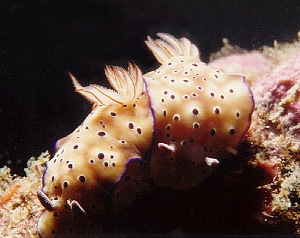
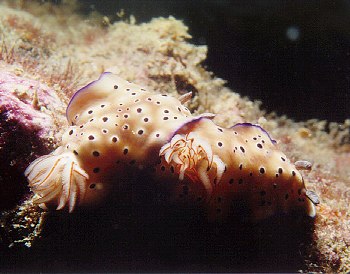
Hi, Bill,
Here is a 2 pictures of Risbecia tryoni. It is from Perhentian, Malaysia.
Correct me if I'm wrong.
Regards,
Alice
alee@dlink.com.sg
Lee, A., 2002 (May 26) Risbecia tryoni from Perhentian, Malaysia. [Message in] Sea Slug Forum. Australian Museum, Sydney. Available from http://www.seaslugforum.net/find/6989Thanks Alice,
Yes this is R. tryoni.
Cheers,
Bill Rudman
Risbecia tryoni from Malaysia
May 9, 2002
From: Barbara Phua
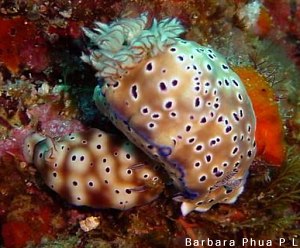
Hi Dr. Rudman,
I found this pair of nudibranchs in the shallow waters off Pulau Chebeh, Malaysia on 16 Mar 2002.
Barbara
babala.pan@pacific.net.sg
Phua, B., 2002 (May 9) Risbecia tryoni from Malaysia. [Message in] Sea Slug Forum. Australian Museum, Sydney. Available from http://www.seaslugforum.net/find/6784Thanks Barbara,
This is Risbecia tryoni.
Best wishes,
Bill Rudman
Risbecia tryoni mating
May 9, 2002
From: Mary Jane Adams
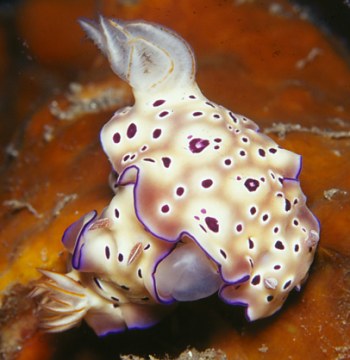
Hi Bill,
I found these Risbecia tryoni in an unusual mating position that allows an interesting view of their sex organs.
Divesite: Nudi Falls,
Lembeh Strait, Sulawesi, Indonesia.
Best regards,
Mary Jane
divepng@yahoo.com
Adams, M J., 2002 (May 9) Risbecia tryoni mating. [Message in] Sea Slug Forum. Australian Museum, Sydney. Available from http://www.seaslugforum.net/find/6862Thanks Mary Jane,
Bill Rudman
Risbecia tryoni from Christmas Island
April 28, 2002
From: Bill Rudman

Here is a record of Risbecia tryoni from John Hicks' Christmas Island, Indian Ocean collections.
PHOTOS:
AM C127585, 26 mm long alive. 13 March 1981, off Cantilever, on living coral, Christmas Is., Indian Ocean. Photo: John Hicks
Best wishes,
Bill Rudman
Risbecia tryoni from Bali
April 4, 2002
From: Stuart Hutchison
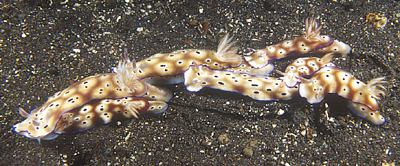
Bill,
Here are several shots of Risbecia tryoni from Bali, Indonesia in October 2001.
Depths varied from 5m to 35m. Lengths from 20mm to 70mm and families from solo to seven! Most common around 7-15m depth.
The juvenile [lower left] is the smallest I've seen.
Stuart
stuart@stuarthutchison.com.au
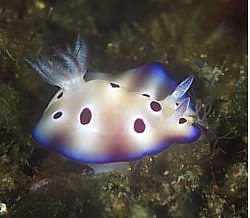
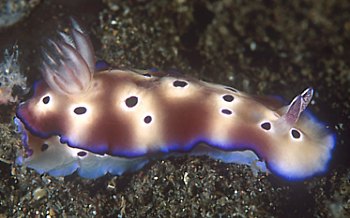
Thanks Stuart,
That's certainly a nudibranch conference in the top photo. A very good example of their trailing behaviour.
Bill Rudman
Risbecia tryoni (2)
April 4, 2002
From: Stuart Hutchison
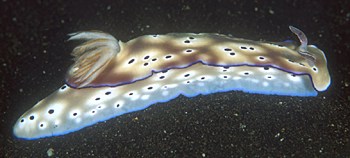
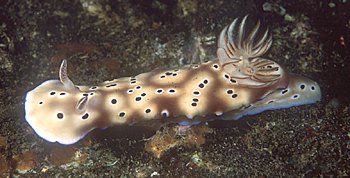
Bill,
Here are some more shots of Risbecia tryoni to add to my earlier ones.
Stuart.
stuart@stuarthutchison.com.au
Hutchison, S., 2002 (Apr 4) Risbecia tryoni (2). [Message in] Sea Slug Forum. Australian Museum, Sydney. Available from http://www.seaslugforum.net/find/6276Juvenile Risbecia tryoni? from Japan
January 11, 2002
From: Rie Nakano
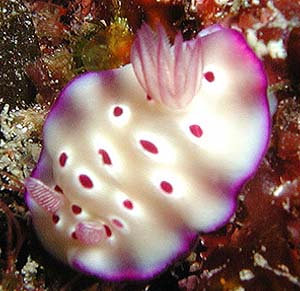
Dear Dr.Rudman,
This very beautiful animal was found on the rocky reef in Hachijo Is. Japan, in December, 2001.
I think this one is a juvenile of Risbecia tryoni. Is that correct?
Length: 8mm
Depth: 12m
On the rocky reef.
Rie Nakano
rie@divers.ne.jp
Nakano, R., 2002 (Jan 11) Juvenile Risbecia tryoni? from Japan. [Message in] Sea Slug Forum. Australian Museum, Sydney. Available from http://www.seaslugforum.net/find/5902Dear Rie,
Yes this is R. tryoni. I agree that the juvenile of this species is usually much more beautiful then the adult.
Best wishes,
Bill Rudman
Risbecia tryoni from Papua New Guinea
October 30, 2001
From: Marli Wakeling
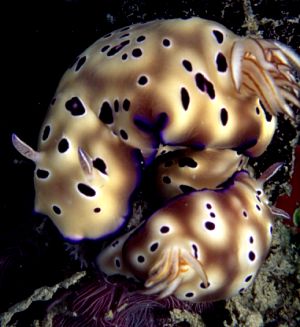
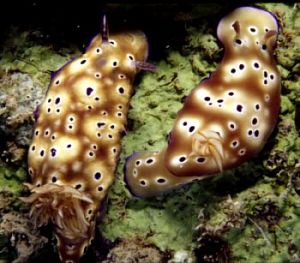
Hi Bill,
These were probably the most common nudibranch I saw on my trip this past summer. Both photos are from the same site, The Old Slipway, in Kavieng Harbour, Papua New Guinea. I found the same animals at the site over several days: they exhibited trailing behaviour and mating, and traveled a fair distance!
Dive Site: The Old Slipway, Kavieng Harbour, Papua New Guinea, July 2001.
Depth: 6 metres
Length: 80mm
Photographs: Marli Wakeling
Marli
scubamarli@excite.com
Wakeling, M., 2001 (Oct 30) Risbecia tryoni from Papua New Guinea. [Message in] Sea Slug Forum. Australian Museum, Sydney. Available from http://www.seaslugforum.net/find/5528Thanks Marli,
For such a relatively common animal we know little about its biology. Did you ever find any animals consistently on the same sponge?
Best wishes,
Bill Rudman
Risbecia tryoni from Exmouth, W.A.
April 8, 2001
From: Kirk Gibson
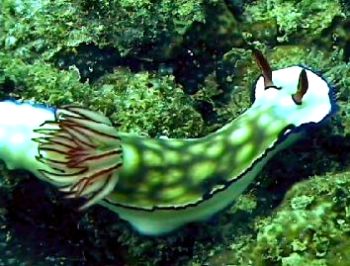
Dear Bill,
This nudibranch was photographed by me on a digital video camera in Exmouth, northern Western Australia in 14m of water. Length 10cm
Kirk Gibson
captainkirk@wn.com.au
Gibson, K., 2001 (Apr 8) Risbecia tryoni from Exmouth, W.A.. [Message in] Sea Slug Forum. Australian Museum, Sydney. Available from http://www.seaslugforum.net/find/4072Thanks Kirk,
It is clearly the same colour form as illustrated in Drew Taylor's recent message. It would be inetersting to know just how widespread this colour form is.
Best wishes,
Bill Rudman
Risbecia tryoni 'tailgating'
March 29, 2001
From: Drew Taylor
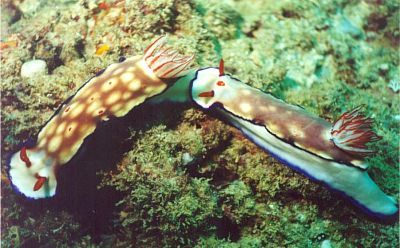
Dear Bill,
Here is a photo of a pair of Risbecia tryoni tailgating. I took it at the Navy Pier, Exmouth, North West Cape, Western Australia, 22 March 2001, in 11 metres of water.
At the same time I found Chromodoris coi laying eggs and a pair of Hypselodoris bullocki mating.
Regards
Drew Taylor
orcaunderwater@nwc.net.au
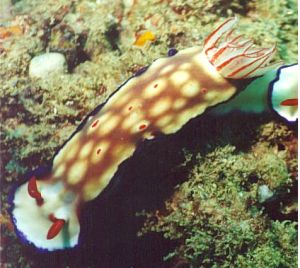
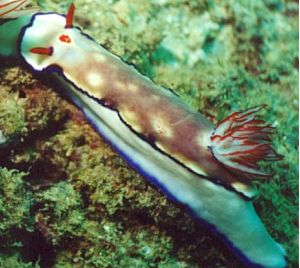
Thanks Drew,
To those of you not familiar with the term 'tailgating' it is used in Australia, and probably originated in the USA, to describe drivers who drive dangerously close to the car in front of them. I must say Drew, that it is quite a good term for this 'trailing' behaviour seen in most species of Risbecia.
The other interesting thing in your photo is the animal! As I discussed in your message about Chromodoris coi, there are some interesting colour variants and distributions in northwestern Australia, and this is another example. Wells & Bryce (1993) recorded this colour form from northwestern Australia. It will be interesting to see how widespread this colour form is.
Best wishes,
Bill Rudman
Risbecia tryoni? from Byron Bay
February 26, 2001
From: David Harasti
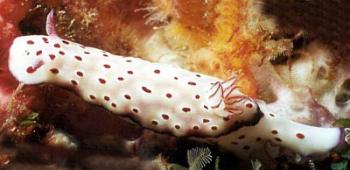
Hi Bill,
This animal was found at Julian Rocks - Byron Bay, NSW. Australia in January 2001. It was found in 15 metres of water and was about 5-6 cm's long. I'm not quite sure of the identification, I think it could be Risbecia tryoni or perhaps even C. daphne.
Thanks for your help.
Cheers,
David
davidh@dynamite.com.au
Harasti, D., 2001 (Feb 26) Risbecia tryoni? from Byron Bay. [Message in] Sea Slug Forum. Australian Museum, Sydney. Available from http://www.seaslugforum.net/find/3851Dear David,
Yes this is R. tryoni. C. daphne, with red spots and a double border of red and yellow, looks rather different.
Best wishes,
Bill Rudman.
Risbecia tryoni from Bora Bora
December 24, 2000
From: Daniel L. Geiger
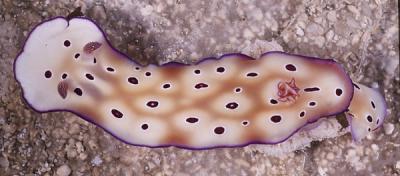
Dear Bill,
Here is a photo of Risbecia tryoni I collected at Bora Bora, in French Polynesia, August 2000.
Daniel.
dgeiger@nhm.org
Geiger, D.L., 2000 (Dec 24) Risbecia tryoni from Bora Bora. [Message in] Sea Slug Forum. Australian Museum, Sydney. Available from http://www.seaslugforum.net/find/3399Thanks Daniel,
Bill Rudman
A very small Risbecia tryoni
September 13, 2000
From: Atsushi Ono
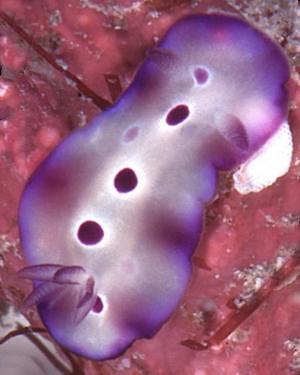
Dear Bill,
I found a juvenile of chromodorid species.
This is similar to C. leopardus and Risbecia tryoni.
Which is correct identification?
To my regret, I didn't take a specimen.
8mm long, at Kerama Is. near Okinawa in Japan. At about 7m depth on coral reef.
Sincerely,
Atsushi Ono
ononini@cosmos.ne.jp
Ono, A., 2000 (Sep 13) A very small Risbecia tryoni. [Message in] Sea Slug Forum. Australian Museum, Sydney. Available from http://www.seaslugforum.net/find/3018Dear Atsushi,
At 8mm long, this is indeed a very juvenile animal. I am pretty sure this is Risbecia tryoni from its general shape and the pinkish tinge to the white mantle gland at the front of the mantle. The glands in R. tryoni often look like this, even in much larger animals.
Best wishes,
Bill Rudman
Trailing Risbecia with commensal shrimp
September 11, 2000
From: M. J. Adams
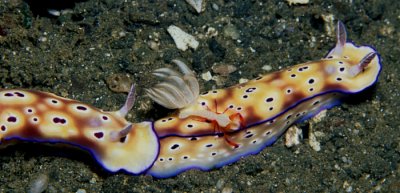
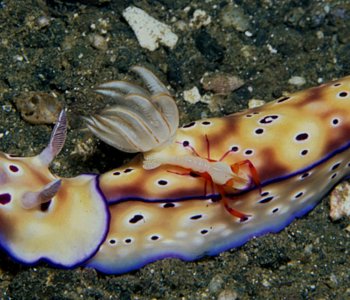
Hi Bill,
Here is a photo that demonstrates both trailing and commensal behavior. Risbecia tryoni with the imperial shrimp, Periclimenes imperator. I found the trio crawling on a sandy bay at Luadi, Papua New Guinea, March, 1998.
Best regards,
Mary Jane.
mjadams@earthlink.net
Adams, M.J., 2000 (Sep 11) Trailing Risbecia with commensal shrimp. [Message in] Sea Slug Forum. Australian Museum, Sydney. Available from http://www.seaslugforum.net/find/2990Thanks Mary Jane,
You've certainly hit the jackpot with this photo.
PS: For anyone not familiar with trailing behaviour in nudibranchs, there are many messages in the Forum with information and observations on the subject. The best way to find them is to use the SEARCH button and type in trailing.
Best wishes,
Bill Rudman.
Trailing in Risbecia tryoni
August 16, 1999
From: Scott Johnson
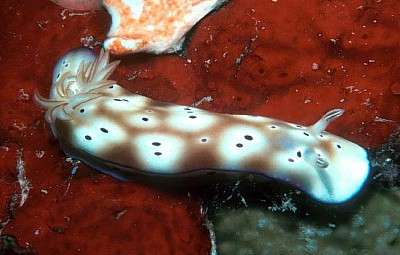
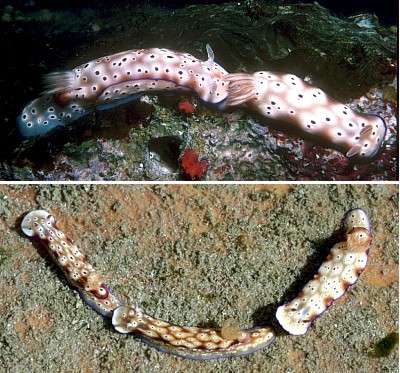
Hi Bill,
After reading the comments several months ago on trailing in Risbecia, I decided to dig out some pictures I had of it. Took me only 4 months. I'm getting faster. Attached are three shots of Risbecia tryoni from Kwajalein and Enewetak Atolls in the Marshall Islands. TOP and MIDDLE PHOTO are from Kwajalein; the first is a single individual and the second shows a pair trailing (or queuing, as I usually refer to it). The BOTTOM PHOTO is from Enewetak and shows three trailing. I admit the latter is a shot in a sea table in the lab, but these three were doing the same when collected on a pier piling. You are correct in saying it's not necessarily the largest that leads; I spent some time in Hawaii studying the behavior in Risbecia imperialis. I'll send some pictures of that species separately.
I too always thought the trailing behavior was unique to Risbecia, which is why when a species that exhibited that behavior showed up in Hawaii a few years back, I assumed without ever checking the radula that it was in that genus. In addition to the trailing behavior, size and shape were also very similar to R. tryoni and R. imperialis. However, Terry Gosliner and Rebecca Johnson recently described it as Hypselodoris paulinae, so it appears that trailing may not be restricted to Risbecia after all.
Scott
johnson@kmr.ll.mit.edu
Johnson, S., 1999 (Aug 16) Trailing in Risbecia tryoni. [Message in] Sea Slug Forum. Australian Museum, Sydney. Available from http://www.seaslugforum.net/find/1195Dear Scott,
Thanks for the photos - comments and photos are never late. I'll post your other messages, which have just arrived, tomorrow. Aren't these animals amazing? Your observation on 'queuing/trailing' in Hypselodoris paulinae is interesting. Behavioural information like 'queuing' and 'gill wiggling' is hard to gather. I sometimes feel I am sounding like a broken record, but I think the message to keep such information, and let us know, is worth repeating.
Bill Rudman.
PS. I think I'll stick to 'trailing' - every time I type 'queuing' I think I have spelt it wrong.
'Trailing' behaviour in Risbecia tryoni
April 8, 1999
From: Erwin Koehler
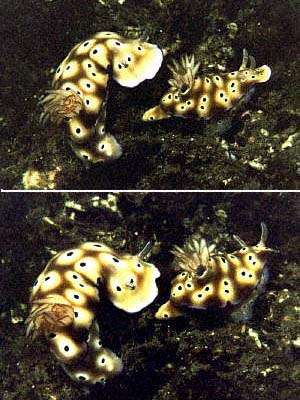
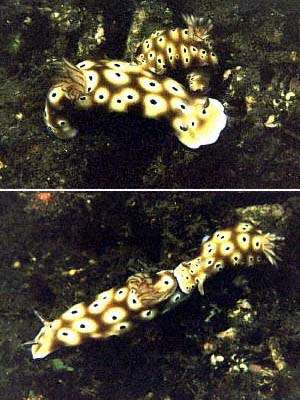
Dear Bill,
Here are 4 photos of a pair of Risbecia tryoni which had lost and found themselves again. [The sequence starts at the top]
Do you know why the large one always goes ahead?
Locality: Philippines,
Negros Is., divesite "Sarah's Place, March 1999, 15m depth.
Erwin
E.Koehler@deutschepost.de
Koehler, E., 1999 (Apr 8) 'Trailing' behaviour in Risbecia tryoni. [Message in] Sea Slug Forum. Australian Museum, Sydney. Available from http://www.seaslugforum.net/find/760Dear Erwin,
Whenever two animals of Risbecia tryoni get together they seem to play "follow the leader". Perhaps its a behaviour which has evolved amongst relatively uncommon animals to ensure they find each other for mating. In this 'trailing' behaviour, one animal appears to follow the mucous trail of the other until they actually make contact. Then the following animal, as you show, keeps contact by touching the 'tail' of the leader.
I don't think the leader is always the biggest but I've never really taken note of that. Anyone else's observations would be welcome.
Other species of Risbecia also do this and I suggested years ago that it could be used as a distinguishing character of the genus .. a bit difficult to find in preserved bottled animals however! I must find time to look out some photos of other species of Risbecia showing this trailing behaviour.
Best wishes,
Bill Rudman.
Risbecia tryoni from the Philippines
January 22, 1999
From: Erwin Koehler
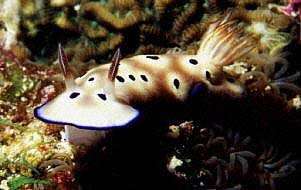
Here is Risbecia tryoni (Garrett, 1873), BBC, Panglao Is., Philippines, November 1998
Erwin
E.Koehler@deutschepost.de
Koehler, E., 1999 (Jan 22) Risbecia tryoni from the Philippines. [Message in] Sea Slug Forum. Australian Museum, Sydney. Available from http://www.seaslugforum.net/find/487Dear Erwin,
For comparison, I have posted pages on three very similarly coloured species of Chromodoris,
Chromodoris geminus, Chromodoris kuniei and Chromodoris leopardus.
Bill Rudman.
